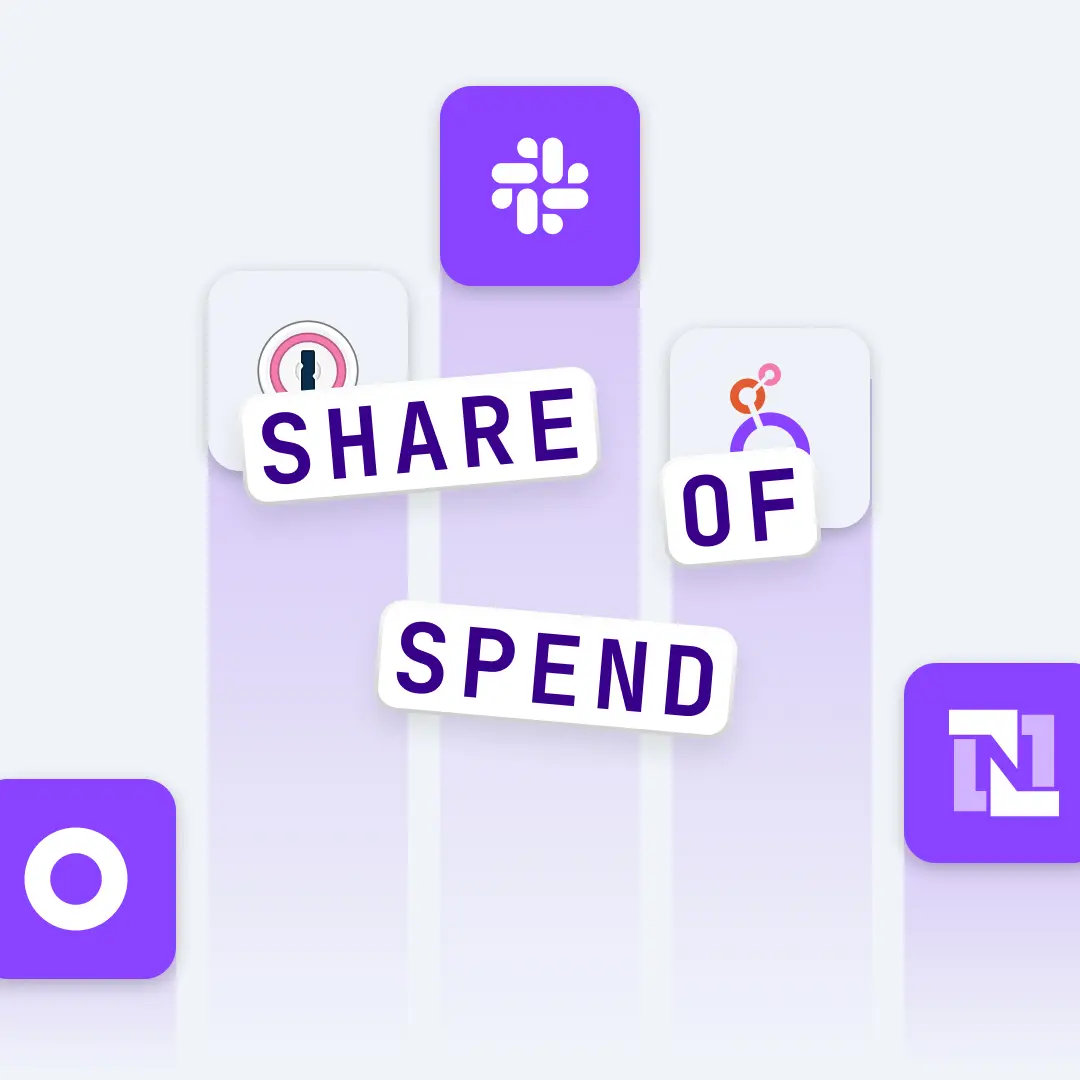Trending Apps
Across SME, Mid-Market and Enterprise
While established platforms such as Salesforce, Microsoft and Google remain staples across businesses of all sizes, our data reveals that Stripe and Twilio have jumped into the top ten most popular SaaS tools among SMEs and mid-market companies – signalling a growing demand for flexible, API-driven applications.
In contrast, enterprises continue to invest heavily in comprehensive platforms such as Workday, ServiceNow, Adobe, and SAP – tools designed to handle the complexity, scale, and integrated demands of larger organizations.
Popular SaaS Apps
A key indicator of software ROI is a high utilization rate, signalling that a tool is relied upon, trusted, and likely delivering consistent value.
Outreach, HiBob, and Tableau are all new additions to the list, indicating that organizations are increasingly prioritizing sales engagement, employee experience, and data-driven decision making.
Figma and Gong have both maintained strong positions year-on-year. Figma, for example, enables distributed teams to design and iterate in real time, embedding itself into daily creative workflows, while Gong delivers critical insights into both existing and prospective customer interactions, making it an indispensable tool for revenue and go-to-market teams.
On The Rise
While OpenAI was the fastest-growing SaaS vendor for four consecutive quarters, it has actually fallen down the rankings, indicating that early hype may be stabilizing as companies reassess their investments and adoption matures.
MongoDB and Canva emerged as top spend priorities for the first time with a 69% and 62% increase in spend, respectively, reflecting strong adoption expanding use cases across development and creative teams.
Vercel is also climbing steadily, highlighting growing investment in modern web infrastructure and front-end deployment tools as companies prioritize performance and scalability.
SaaS Insights
SaaS Inflation vs. Market Inflation (Jul'24 to Sep'25)
.webp)
SaaS inflation rate
For a business that spent $1,000,000 on software in 2024, this translates to an additional $123,000 for the exact same tech stack – with no added features, seats, capabilities, or services.
After peaking at 14% in May 2025, SaaS inflation eased slightly in July and August, settling at 12.3% in September. While this suggests a temporary slowdown in price growth, SaaS inflation remains elevated compared to early 2025 levels and continues to outpace the US annual CPI of 2.9% by roughly 4x.
.webp)
After peaking at 14% in May 2025, SaaS inflation eased slightly in July and August, settling at 12.3% in September.
30% of SaaS contracts impacted by shrinkflation
.webp)
SaaS shrinkflation
By the end of September 2025, 30% of all contracts we renewed for our customers across the globe had been affected by “SaaS shrinkflation” – a practice in which vendors charge the same price or more for reduced functionality.
Worryingly, SaaS shrinkflation is not only becoming harder to detect, but it is on the rise, having increased by 20.5% since 2024. Vendors often use opaque tactics such as product bundling, unbundling, and currency harmonization to mask feature reductions.
It’s also particularly common in enterprise-level plans, where customized pricing makes reductions easier to conceal. Typical examples include fewer licenses, admin users, or contacts.

Almost a third of SaaS contracts in the past year have been impacted by "SaaS shrinkflation," where vendors quietly reduce features while either raising prices or keeping them the same.
SaaS Spend Per Employee (Q4'23 to Q3'25)

SaaS Spend Per Employee
As of Q3, 2025, employees cost organizations an average of $9,200 per annum in SaaS spend, compared to an average of $8,700 across the whole of 2023, and $6,900 in 2023 – a 33% increase.
This sharp rise in SaaS spend per employee is down to a perfect storm of factors:
- SaaS price increases - Software inflation has been climbing steadily over the past couple of years, reaching a Q3 2025 average of 12.5%.
- Headcount cuts - Layoffs continue to mount, with more than 90,000 tech jobs having already been cut in 2025. Despite this deduction in headcount, companies can’t immediately reduce their SaaS spend, as they are often locked into annual or multi-year contracts, typically tied to user counts.
- The proliferation of point-SaaS - Many companies have built their tech stacks with ‘point solutions’ to solve specific problems, often resulting in a costly accumulation of tools and a higher overall spend per employee.
.webp)
As of Q3, 2025, employees cost organizations an average of $9,200 per annum in SaaS spend, compared to an average of $8,700 across the whole of 2023, and $6,900 in 2023 – a 33% increase.
SaaS by Pricing Type (Sep'24 to Sep'25)

SaaS Pricing Models
With the rise of AI, speculation has grown around a shift from the traditional seat-based model to more flexible usage-based pricing. While the transition is slower than some experts predicted, a clear trend is emerging.
As of September 2025, 39% of SaaS contracts use seat-based pricing, down from 43% the previous year. In this same period, usage-based pricing has grown from 32% to 34%, while hybrid pricing increased from 25% to 27%.
This gradual but continual shift suggests that companies are demanding more flexibility in how they pay for software, and vendors are responding with increasingly hybrid and usage-based models to accommodate different products and customer needs.
Nick Riley, Global Head of Purchasing at Vertice, explains:
“Household names like Salesforce and Snowflake have announced moves away from charging by user or seat, which has likely given the impression that the switch to usage-based pricing is happening more quickly. In reality, many vendors seem to be watching and waiting - seeing how it plays out in the long term before making drastic changes.”

As of September 2025, 39% of SaaS contracts use seat-based pricing, down from 43% the previous year. In this same period, usage-based pricing has grown from 32% to 34%, while hybrid pricing increased from 25% to 27%.
Average SaaS Applications Per Business (Jul'24 to Sep'25)
.webp)
SaaS Apps Per Business
The number of SaaS tools being used by organizations continues to rise, with the average company now using 135 different tools – seven more than they were a year ago.
Advancements in technology can, to some extent, explain this surge, as companies continue to invest in new, innovative tools such as AI-driven solutions. Additional data from Vertice indicates that AI tools now account for 0.5% of total software spend within the average organization, up almost 400% in enterprise organizations.
Lack of procurement oversight may also be contributing to rising numbers, with as many as 21% of tools going entirely unused, and a further 45% underutilized within organizations. In the average company, 18 tools are entirely redundant.

The average tech stack now consists of 135 software applications – up 5% in just one year.
Top SaaS vendors by renewals
Stickiest SaaS tools
High software renewal rates indicate tools that are embedded in daily workflows and consistently deliver ROI – often becoming indispensable.
For finance and procurement leaders, tracking the most widely retained applications offers insight into what’s working across the market and highlights potential gaps in their own tech stacks, guiding smarter investment and renewal decisions.
Over the past year, the top five stickiest SaaS applications have shifted significantly:
- Asana takes the top spot, reflecting its central role in team collaboration and project management.
- Mimecast moves into second place, underscoring the continued importance of email security and compliance solutions.
- Greenhouse ranks third, highlighting the focus on structured hiring and talent management.
- Fivetran rises to fourth, emphasizing demand for automated, reliable data integration.
- Splunk rounds out the top five, showing that analytics and operational intelligence remain critical for business decision-making.
Compared to September 2024, four of these tools are new entries, signaling shifting priorities toward collaboration, security, and data-driven workflows.

High software renewal rates indicate tools that are embedded in daily workflows and consistently deliver ROI – often becoming indispensable.
Top SaaS categories by duplication
& Productivity
& Productivity
Tool Overload
As vendors in Security, Sales, Marketing, and Collaboration expand their capabilities to increase stickiness, organizations are increasingly adopting multiple overlapping tools. With department heads gaining more autonomy to purchase software, this redundancy drives overspend and introduces security and compliance risks.
Development and Security tools see the highest duplication, often used across multiple teams. For example, security monitoring platforms are deployed by both Security and IT Operations teams, as each requires real-time threat detection and system integrity monitoring.
Sales and Marketing platforms are also prone to duplication. Fierce competition pushes vendors to expand functionality, and large tech stacks across both departments create overlapping capabilities – a perfect storm for wasted spend and inefficiency.
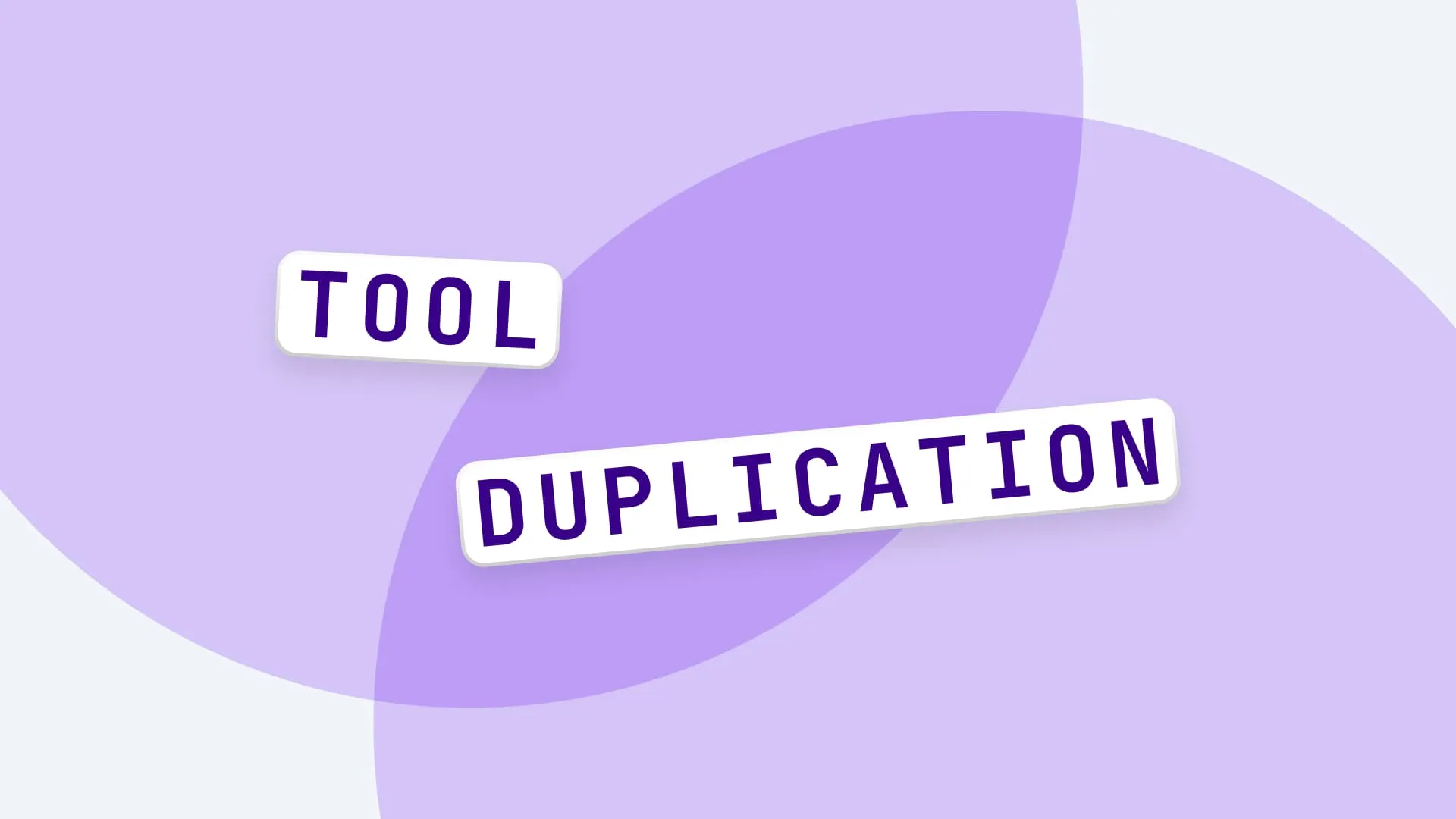
As vendors in Security, Sales, Marketing, and Collaboration expand their capabilities to increase stickiness, organizations are increasingly adopting multiple overlapping tools.
Unused SaaS Applications (%)

Software Wastage
Between September 2024 and September 2025, SaaS application usage increased from 78% to 81%, reflecting a growing emphasis on maximizing value from existing software investments, amid rising costs and mounting pressure to do more with less.
Despite this growth, almost one-fifth (19%) of all SaaS tools remain entirely unused, effectively becoming shelfware. With the average company now using 135 applications, this represents a significant amount of wastage – contributing to the millions of dollars lost each year by many organizations.
Some of the most common reasons why SaaS tools go unused include:
- Maverick spending: Employees purchase tools outside centralized procurement processes.
- Lack of integration: Tools fail to connect with existing workflows or systems.
- Limited adoption: Teams do not fully adopt the software.
- Falling off the radar: Purchased tools are forgotten or deprioritized over time.

Between September 2024 and September 2025, SaaS application usage increased from 78% to 81%, reflecting a growing emphasis on maximizing value from existing software investments, amid rising costs and mounting pressure to do more with less.
Top SaaS categories by cancelations
Most Canceled saaS Tools
Our latest cancellation data shows that organizations are struggling to capture sufficient value from certain types of software at the point of renewal.
As of September 2025, the top five categories seeing the highest rates of cancellations are:
- Professional Services – Consistently the most frequently cut, reflecting scrutiny over cost versus ROI.
- Business Services – Often deprioritized when internal processes can replace external solutions.
- CRM – Adoption or integration challenges may limit perceived value.
- Customer Service – Platforms may be seen as less critical during budget tightening.
- Vertical Industry Tools – Highly specialized tools that are harder to justify across the organization.
Interestingly, HR and AI tools, once among the most cancelled last year, have dropped off the top cancellation list, indicating that companies now view them as strategic, essential investments.
.webp)
Our latest cancellation data shows that organizations are struggling to capture sufficient value from certain types of software at the point of renewal.
Top SaaS categories by underutilization
SaaS Underutilization
Underutilization continues to drain budgets – often result of duplicate applications and overprovisioned licenses.
As of Q3 2025, Project Management and Content Management are the least-utilized software categories, pointing to widespread over-contracting on per-user pricing models. HR tools remain high on the list, with Office Management and Customer Service having also joined the top five.
Interestingly, Security and IT Management tools have dropped out of the rankings, suggesting organizations may be getting better at aligning spend with actual needs in these categories. However, higher rates of underutilization among Office Management and Customer Service tools show that usage issues are now affecting functions once considered essential – making it critical for procurement teams to closely track software usage and negotiate contract terms accordingly.
.webp)
As of Q3 2025, Project Management and Content Management are the least-utilized software categories, pointing to widespread over-contracting on per-user pricing models.
SaaS wastage by company size (% vs. $)
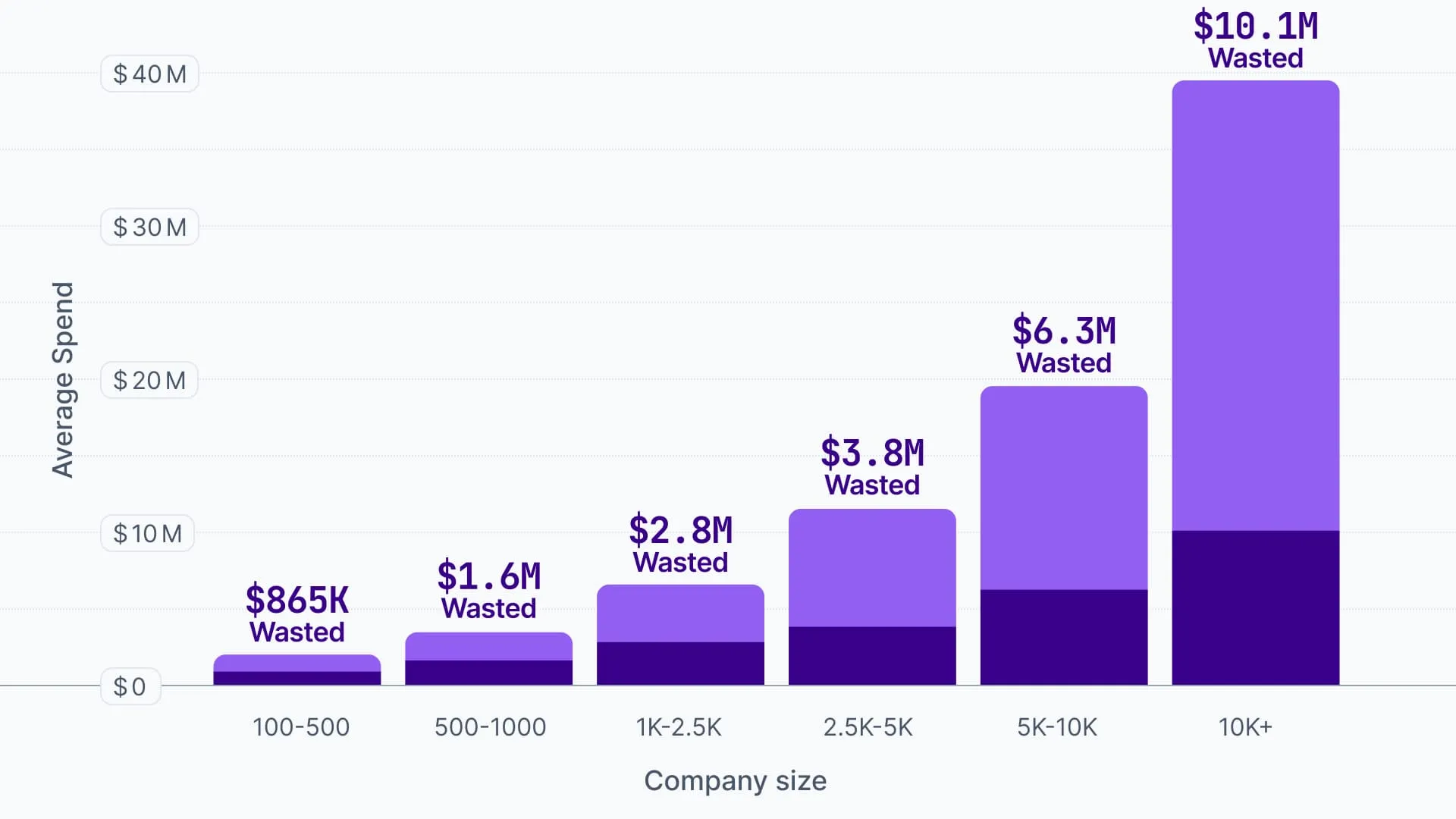
Cost of Unused SaaS
Organizations with between 100 and 500 employees waste an average of $865,000 a year on tools that are either entirely unused or underutilized. This figure only increases as a company scales, surpassing $1.5 million a year for those with more than 500 employees, and as much as $10 million a year for enterprises with more than 10,000 employees.
This trend highlights the growing complexity of managing sprawling software stacks and the lack of visibility into actual usage. With such vast sums at stake, even modest SaaS management improvements can yield major savings. Rightsizing contracts based on real usage data is one of the most effective ways that organizations can cut unnecessary costs and improve operational efficiency.
.webp)
Companies stand to save millions of dollars by rightsizing their contracts and eliminating unused tools and licenses.
Procurement Insights
Additional savings achieved compared to contract negotiations started <30 days before renewal
.webp)
Renewal Savings vs. Negotiation Time
Contract renewals typically need less runway to start a negotiation when compared to a new purchase. However, procurement needs to be careful not to become complacent.
Significantly larger savings can be made in SaaS renewals if negotiations are started 90 days or more before the renewal date - 49% greater than if started under 30 days before, and 19% more if negotiations are begun between 30 and 90 days.
Notable examples include Analytics and Monitoring suppliers - with whom it’s almost a necessity to start renewal conversations over 90 days before the renewal date, otherwise the chance of discount improvement is almost nil. Start earlier though, and procurement can improve their discount on Analytics tools by an astronomical 74%.
It’s a similar story in many categories, from HR and IT infrastructure to Monitoring and Project Management. And in Customer Service, it’s even possible to more than double your discount simply by starting a conversation earlier.
Having a well-structured, collaborative and data-driven procurement workflow can give the procurement team the process they need to start negotiating as soon as possible. Many get stuck in trying to manually push new intake requests and renewals through the workflow and fight fires along the way, leaving them very little time to get ahead of the game and work on early negotiations.
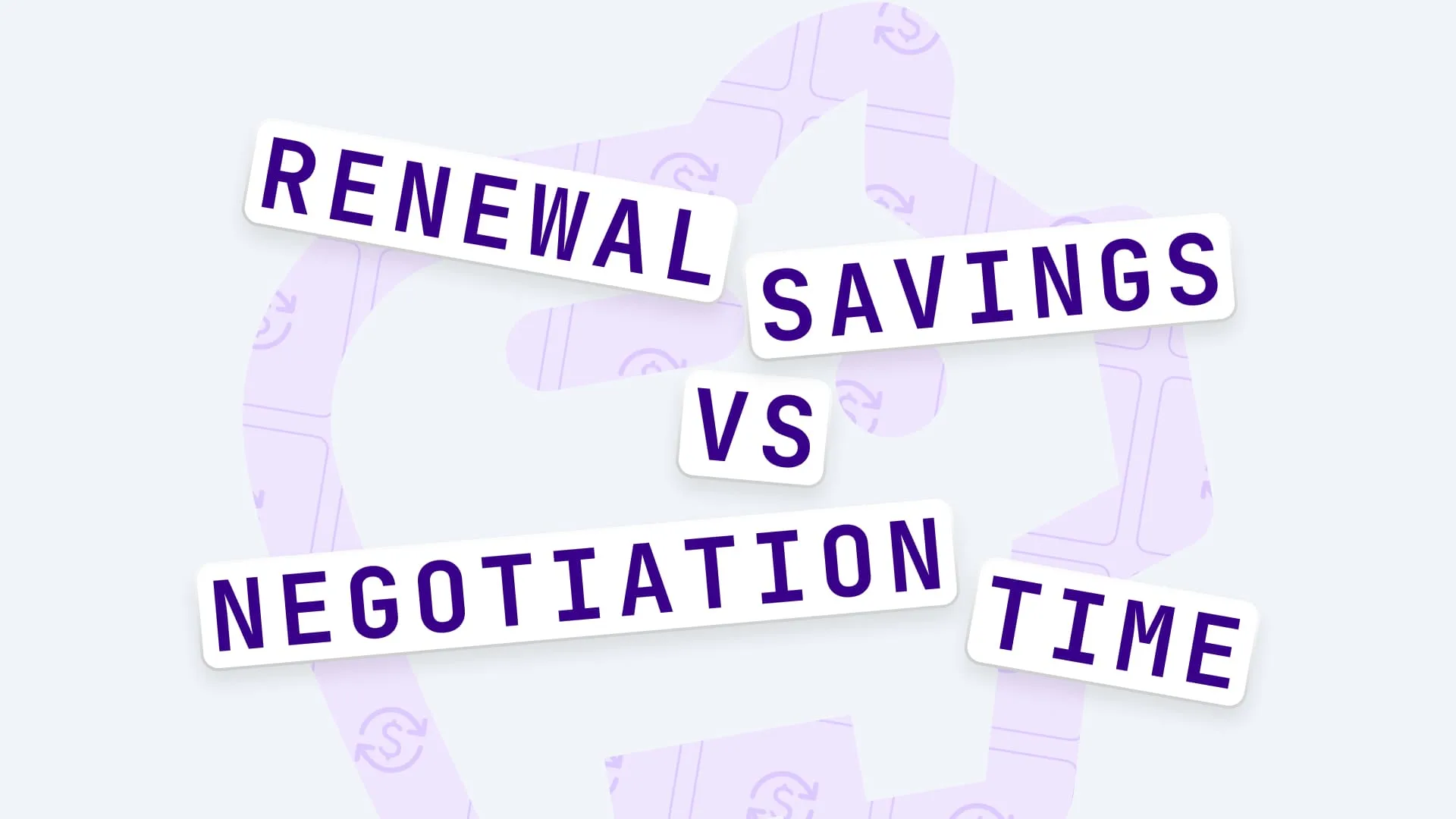
Those who start negotiations 90+ days in advance of contract renewal dates achieve significantly higher savings across all SaaS categories - with on average 49% greater discount than the vendors’ standard offer.
Vendor ISO 27001 vs SOC2 certifications (%)

Supplier Compliance Rates
Monitoring the compliance certification of vendors helps avoid regulatory penalties by ensuring your suppliers don’t undermine your security, data privacy or procedural frameworks and safeguards. And for some businesses, will even be crucial for working with their own customers.
And given how many SaaS vendors do not hold both of the most commonly-requested certifications, it emphasizes how important it is to consider having your compliance approval stage as early in the request workflow as possible - perhaps even at the intake stage itself.
Categories like CRM, Project Management, Customer Service, Monitoring and Analytics all process a lot of customer data, so seeing that 100% of the vendors that Vertice has worked with in these categories within the last 12 months have SOC 2 compliance is to be expected. But then large swathes of these vendors then make themselves harder to work with - for some, impossible - as so many lack the broader IT security certification of ISO 27001.
Granted, many of these vendors may be targeting businesses below enterprise level and therefore not deem it vital. And for many procurement teams, ISO 27001 may not be a requirement. Or at least not today… procurement then has to consider if their growth ambitions mean they will require ISO 27001 later down the line, and within the period of the contract.

While the number of SaaS vendors holding either SOC2 or ISO 27001 is generally high, the number holding both is less than half (45%).
Time to approve by department (Days)
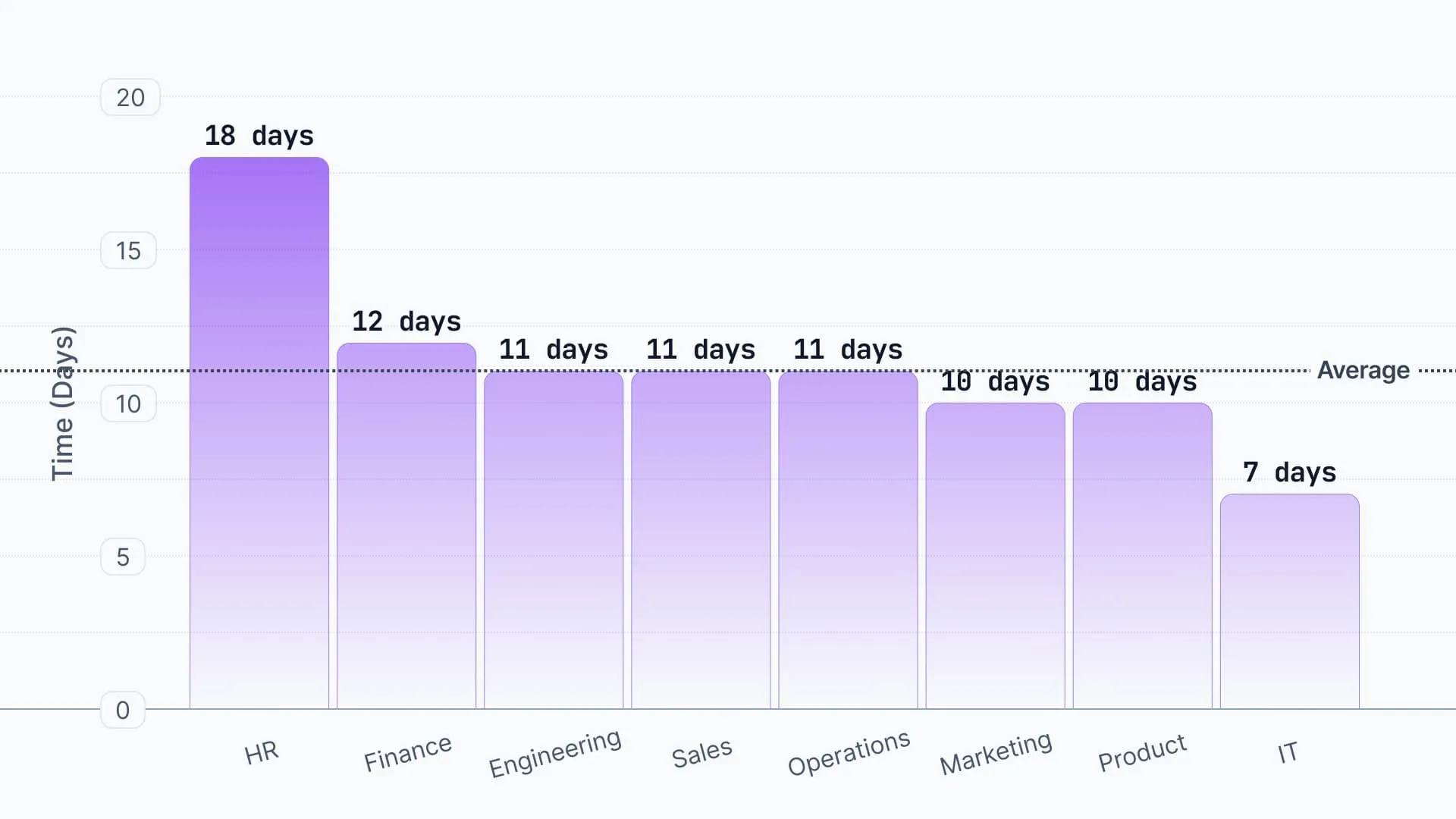
Approval times By function
Software approval times are relatively consistent across departments, averaging around 10 days. However, there are some notable variations that may reflect how different teams prioritize and justify their technology needs. IT teams, for example, see the fastest approval turnaround at just seven days – likely due to the critical nature of their tools in maintaining core systems and infrastructure.
In contrast, HR requests take slightly longer to approve, averaging 18 days. This delay could be a result of HR tools being seen as less urgent, carrying more compliance or privacy considerations, or facing closer scrutiny around cost and integration with existing systems. It’s also possible that HR software often affects multiple parts of the business – such as payroll, onboarding, or employee engagement – prompting longer review cycles involving several stakeholders.
This is just one metric that top procurement teams use to set their performance apart. Find out what the others are in our Procurement Metrics that Matter report.

Teams are taking 11 days on average to approve contracts, but some take significantly longer than others.
Average contract length by SaaS category (Months)

Average Contract Length
With an average of just over 19 months, companies seem to prefer shorter contract terms - even in the face of attractive discount offers, placing higher value on flexibility.
It is however noticeable that businesses are more willing to commit to longer contract terms in certain areas. HR systems, CRM platforms and ERPs stand out as among the longest average commitments - approx 2 years - largely because businesses seek to minimize the disruption of regularly reviewing options and re-negotiating for platforms that are central to business operations.
On the flip side, Project Management, Collaboration and Development tools tend to have much shorter contracts, between 14 and 17 months - as departments experiment with the efficacy of these tools and find it much easier to chop and change them.
But this is the sort of data that only the top 1 in 6 procurement leaders are using. See what other data points they use, and compare them to your own metrics.

Companies are locking in SaaS for over a year and a half on average.
Average post vendor-selection stage completion time (Days)
Procurement process stage completion times
(post vendor selection)
Negotiations take, on average, 21.4 days to complete - and even as much as 37 days. This explains, for example, why renewal negotiations that start more than 90 days before the auto-renewal point deliver such greater discounts, as leverage is not lost.
While many subsequent approval stages take less than a week, procurement leaders should be wary of the tendency for some of these to stages to drift - often needlessly - into two weeks. By assessing what is causing these delays, whether not having necessary data to hand, poor prioritisation, or failing to integrate the workflows with the collaboration / project management tools they prefer to use, procurement can cut crucial time from the process and help the business move faster.
But only 1 in 6 leaders use these metrics. The Procurement Metrics That Matter Report reveals the metrics the top performers use, and why they are so much more impactful than those traditionally used.
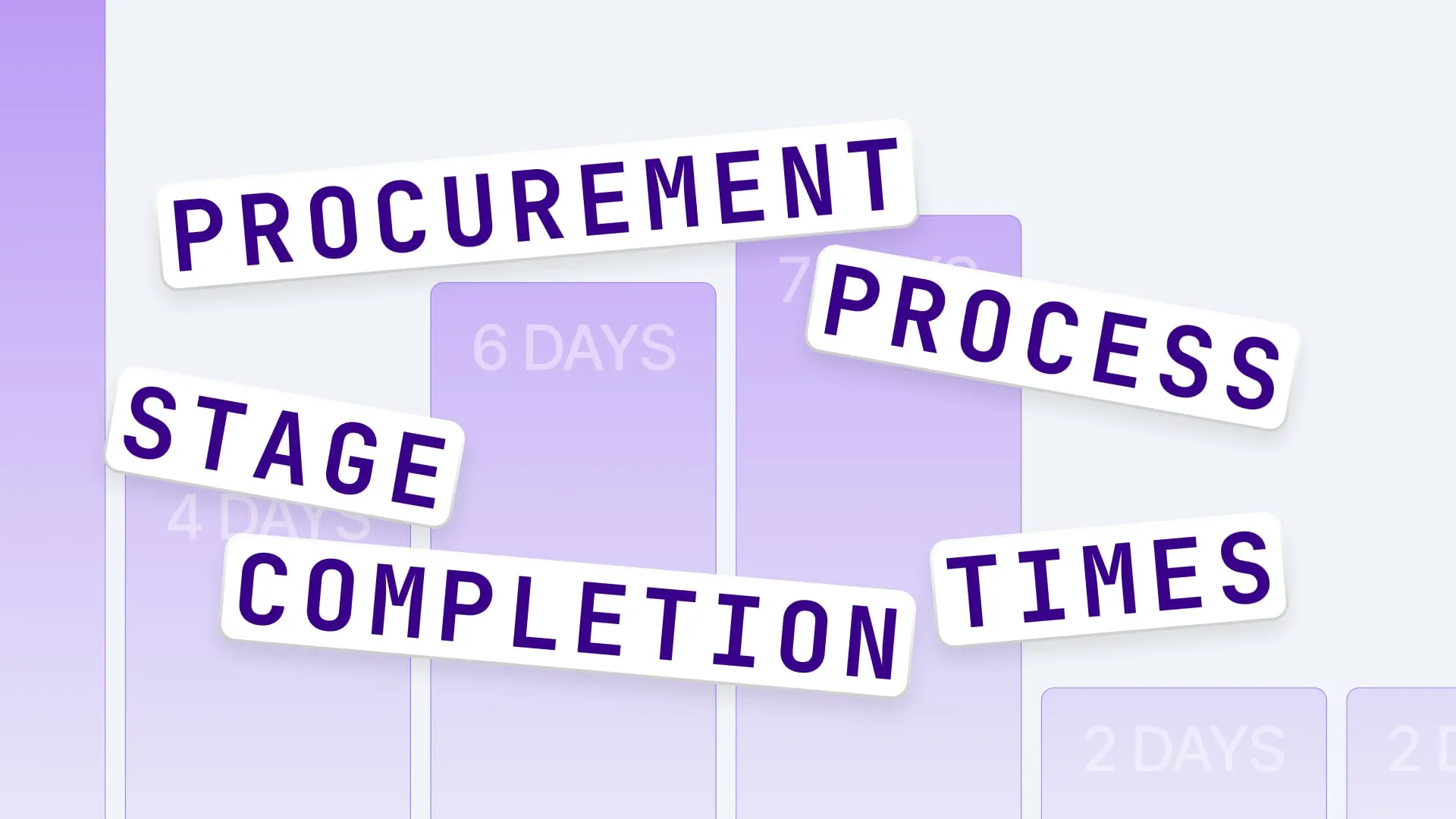
With high percentages of most stages taking less than 24 hours to complete, this suggests there is room for improvement.
Deviation between minimum and maximum benchmark prices by SaaS category

Pricing benchmark deviation
Knowing a ‘fair’ or ‘common’ price for B2B software is often impossible. Given the variations in contract terms, pricing models, feature sets and user tiers, plus how few vendors make pricing public, it can be hard for procurement teams to know where to start a negotiation.
This of course makes benchmark data crucial. But even then, the gap between minimum and maximum pricing benchmark per SaaS category can vary wildly. Sales tools show the biggest deviation, with some companies paying over 3x more than others for near-identical functionality and terms. Marketing and ERP tools also have high rates of deviation (2.85x and 2.5x).
Sales and Marketing tools are some of the most duplicated, as teams often bring in tools whose functionality partially overlaps, creating a dual problem - high potential prices, plus high wasted spend.

Companies can pay over 3x more for similar tools than others.
Requests missing required intake information (%)
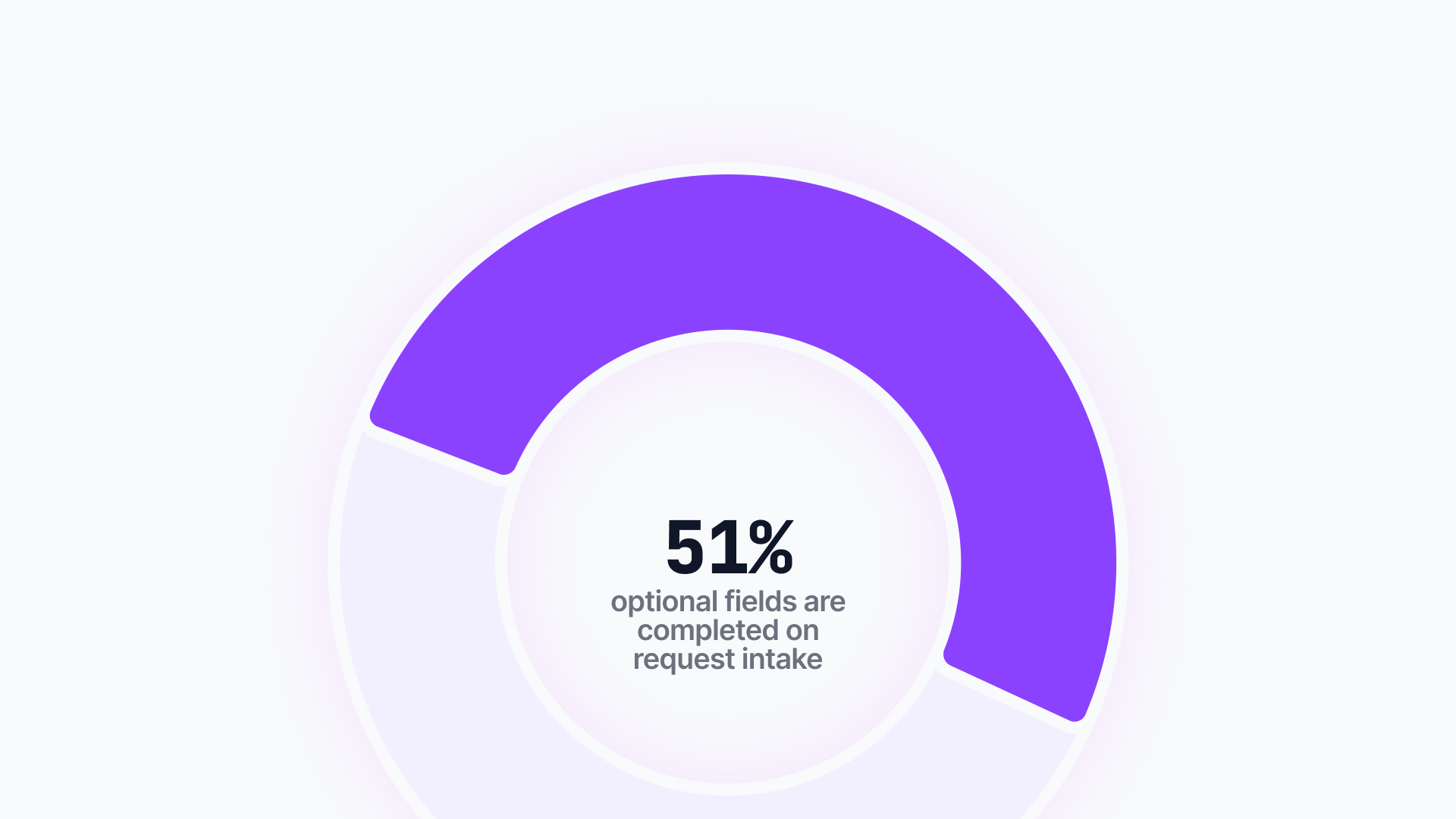
Missing Required FIelds
When requesting new software, employees tend to omit important details needed for procurement to accurately evaluate and process requests. Only about half of all optional fields are completed, with the most commonly missing information including signing entity, additional notes, vendor contact email, and contract length.
While not every missing field is critical, the signing entity and contract length are particularly important for procurement and finance teams to draft contracts and manage budgets effectively. Incomplete submissions often lead to delays, as procurement and finance must follow up to gather necessary information before proceeding with the purchase request.
This suggests the need for many organizations to evaluate the intake process. Making truly essential fields mandatory, improving form design, and providing clearer guidance could help reduce information gaps, subsequently helping to streamline software requests, speed up approvals, and reduce administrative bottlenecks.
.webp)
Almost half (49%) of all optional fields are left blank within purchase requisition forms, impacting the efficiency and speed of software procurement.

























































